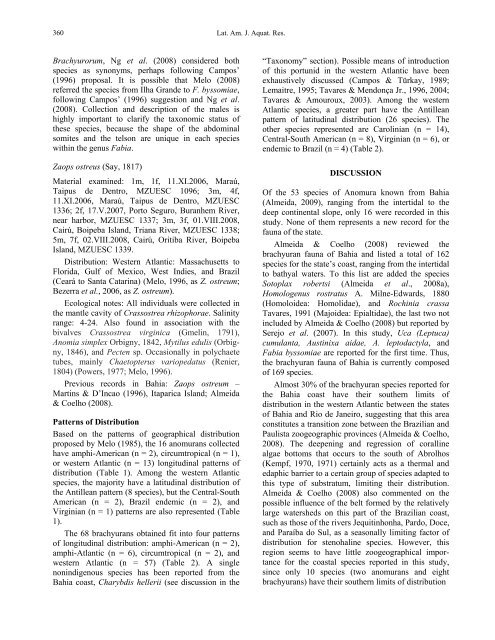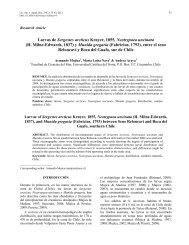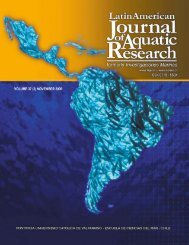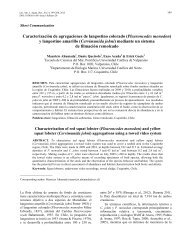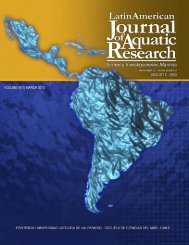Portada LAJAR.psd - Latin American Journal of Aquatic Research
Portada LAJAR.psd - Latin American Journal of Aquatic Research
Portada LAJAR.psd - Latin American Journal of Aquatic Research
You also want an ePaper? Increase the reach of your titles
YUMPU automatically turns print PDFs into web optimized ePapers that Google loves.
360<br />
Brachyurorum, Ng et al. (2008) considered both<br />
species as synonyms, perhaps following Campos’<br />
(1996) proposal. It is possible that Melo (2008)<br />
referred the species from Ilha Grande to F. byssomiae,<br />
following Campos’ (1996) suggestion and Ng et al.<br />
(2008). Collection and description <strong>of</strong> the males is<br />
highly important to clarify the taxonomic status <strong>of</strong><br />
these species, because the shape <strong>of</strong> the abdominal<br />
somites and the telson are unique in each species<br />
within the genus Fabia.<br />
Zaops ostreus (Say, 1817)<br />
Material examined: 1m, 1f, 11.XI.2006, Maraú,<br />
Taipus de Dentro, MZUESC 1096; 3m, 4f,<br />
11.XI.2006, Maraú, Taipus de Dentro, MZUESC<br />
1336; 2f, 17.V.2007, Porto Seguro, Buranhem River,<br />
near harbor, MZUESC 1337; 3m, 3f, 01.VIII.2008,<br />
Cairú, Boipeba Island, Triana River, MZUESC 1338;<br />
5m, 7f, 02.VIII.2008, Cairú, Oritiba River, Boipeba<br />
Island, MZUESC 1339.<br />
Distribution: Western Atlantic: Massachusetts to<br />
Florida, Gulf <strong>of</strong> Mexico, West Indies, and Brazil<br />
(Ceará to Santa Catarina) (Melo, 1996, as Z. ostreum;<br />
Bezerra et al., 2006, as Z. ostreum).<br />
Ecological notes: All individuals were collected in<br />
the mantle cavity <strong>of</strong> Crassostrea rhizophorae. Salinity<br />
range: 4-24. Also found in association with the<br />
bivalves Crassostrea virginica (Gmelin, 1791),<br />
Anomia simplex Orbigny, 1842, Mytilus edulis (Orbigny,<br />
1846), and Pecten sp. Occasionally in polychaete<br />
tubes, mainly Chaetopterus variopedatus (Renier,<br />
1804) (Powers, 1977; Melo, 1996).<br />
Previous records in Bahia: Zaops ostreum –<br />
Martins & D’Incao (1996), Itaparica Island; Almeida<br />
& Coelho (2008).<br />
Patterns <strong>of</strong> Distribution<br />
Based on the patterns <strong>of</strong> geographical distribution<br />
proposed by Melo (1985), the 16 anomurans collected<br />
have amphi-<strong>American</strong> (n = 2), circumtropical (n = 1),<br />
or western Atlantic (n = 13) longitudinal patterns <strong>of</strong><br />
distribution (Table 1). Among the western Atlantic<br />
species, the majority have a latitudinal distribution <strong>of</strong><br />
the Antillean pattern (8 species), but the Central-South<br />
<strong>American</strong> (n = 2), Brazil endemic (n = 2), and<br />
Virginian (n = 1) patterns are also represented (Table<br />
1).<br />
The 68 brachyurans obtained fit into four patterns<br />
<strong>of</strong> longitudinal distribution: amphi-<strong>American</strong> (n = 2),<br />
amphi-Atlantic (n = 6), circumtropical (n = 2), and<br />
western Atlantic (n = 57) (Table 2). A single<br />
nonindigenous species has been reported from the<br />
Bahia coast, Charybdis hellerii (see discussion in the<br />
Lat. Am. J. Aquat. Res.<br />
“Taxonomy” section). Possible means <strong>of</strong> introduction<br />
<strong>of</strong> this portunid in the western Atlantic have been<br />
exhaustively discussed (Campos & Türkay, 1989;<br />
Lemaitre, 1995; Tavares & Mendonça Jr., 1996, 2004;<br />
Tavares & Amouroux, 2003). Among the western<br />
Atlantic species, a greater part have the Antillean<br />
pattern <strong>of</strong> latitudinal distribution (26 species). The<br />
other species represented are Carolinian (n = 14),<br />
Central-South <strong>American</strong> (n = 8), Virginian (n = 6), or<br />
endemic to Brazil (n = 4) (Table 2).<br />
DISCUSSION<br />
Of the 53 species <strong>of</strong> Anomura known from Bahia<br />
(Almeida, 2009), ranging from the intertidal to the<br />
deep continental slope, only 16 were recorded in this<br />
study. None <strong>of</strong> them represents a new record for the<br />
fauna <strong>of</strong> the state.<br />
Almeida & Coelho (2008) reviewed the<br />
brachyuran fauna <strong>of</strong> Bahia and listed a total <strong>of</strong> 162<br />
species for the state’s coast, ranging from the intertidal<br />
to bathyal waters. To this list are added the species<br />
Sotoplax robertsi (Almeida et al., 2008a),<br />
Homologenus rostratus A. Milne-Edwards, 1880<br />
(Homoloidea: Homolidae), and Rochinia crassa<br />
Tavares, 1991 (Majoidea: Epialtidae), the last two not<br />
included by Almeida & Coelho (2008) but reported by<br />
Serejo et al. (2007). In this study, Uca (Leptuca)<br />
cumulanta, Austinixa aidae, A. leptodactyla, and<br />
Fabia byssomiae are reported for the first time. Thus,<br />
the brachyuran fauna <strong>of</strong> Bahia is currently composed<br />
<strong>of</strong> 169 species.<br />
Almost 30% <strong>of</strong> the brachyuran species reported for<br />
the Bahia coast have their southern limits <strong>of</strong><br />
distribution in the western Atlantic between the states<br />
<strong>of</strong> Bahia and Rio de Janeiro, suggesting that this area<br />
constitutes a transition zone between the Brazilian and<br />
Paulista zoogeographic provinces (Almeida & Coelho,<br />
2008). The deepening and regression <strong>of</strong> coralline<br />
algae bottoms that occurs to the south <strong>of</strong> Abrolhos<br />
(Kempf, 1970, 1971) certainly acts as a thermal and<br />
edaphic barrier to a certain group <strong>of</strong> species adapted to<br />
this type <strong>of</strong> substratum, limiting their distribution.<br />
Almeida & Coelho (2008) also commented on the<br />
possible influence <strong>of</strong> the belt formed by the relatively<br />
large watersheds on this part <strong>of</strong> the Brazilian coast,<br />
such as those <strong>of</strong> the rivers Jequitinhonha, Pardo, Doce,<br />
and Paraíba do Sul, as a seasonally limiting factor <strong>of</strong><br />
distribution for stenohaline species. However, this<br />
region seems to have little zoogeographical importance<br />
for the coastal species reported in this study,<br />
since only 10 species (two anomurans and eight<br />
brachyurans) have their southern limits <strong>of</strong> distribution


